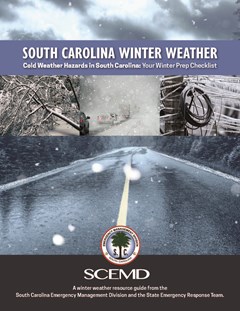Heavy snowfall, ice, and extreme cold can immobilize an entire region. Even areas that normally experience mild winters can be hit with a major winter storm or extreme cold.
Snow and ice storms, coupled with cold temperatures, periodically threaten South Carolina. Winter storms can damage property, close highways, create safety risks such as hypothermia, destroy crops and valuable timber, damage infrastructure components such as power lines and have enormous economic impacts.
Winter Weather: Know the Terms
Winter Storm Watch is used when the risk of a hazardous winter weather event has increased, but its occurrence, location, and/or timing is still uncertain (heavy sleet, heavy snow, ice storm, blowing snow, or combination of events).
Winter Storm Warning is issued for a significant winter weather event, including snow, ice sleet, or blowing snow, or a combination of these hazards.
Winter Weather Advisory is issued when snow, blowing snow, ice, sleet, or a combination of these wintry elements is expected, but conditions should not be hazardous enough to meet warning criteria.
Ice Storm Warning is usually issued for ice accumulation around 1/4 inch or more. This amount of ice accumulation will make travel dangerous or impossible, likely leading to snapped power lines and falling tree branches.
Freezing Rain is rain that freezes when it hits the ground, creating a coating of ice on roads, walkways, trees and power lines.
Sleet is rain that turns into ice pellets before reaching the ground. Sleet can create dangerous driving conditions.
Freeze Warning freezing temperatures for an extended period are expected.
Extreme Cold Warning dangerously cold air temperatures or wind chill values are expected or occurring. Avoid going outside if possible.
Extreme Cold Watch dangerously cold air temperatures or wind chill values are possible.
Cold Weather Advisory issues when cold temperatures/ wind chill temperatures are expected to result in significant impacts to people and/or infrastructure.
- Add rock salt and shovels to your supply kit.
- Pet safety: opt for ice melt products labeled "pet-safe." Avoid rock salt (sodium chloride) and antifreeze, as these can be harmful to pets.
- Stock up on heating fuel for potential isolation or power loss.
- Insulate pipes and let faucets drip to prevent freezing.
- Learn how to shut off water valves in case a pipe bursts.
- Service your vehicle for winter readiness.
- Keep a winter emergency kit in each vehicle, including a shovel, scraper, flashlight, radio, batteries, water snacks, matches, extra clothing, a first aid kit, medications, blankets, tow chain, salt, booster cables, flares and distress flag.
- Stay indoors. If you go out, dress in layers: a scarf and waterproof insulated boots.
- Avoid overexertion when shoveling snow; stretch before and take plenty of breaks.
- Change wet clothing to prevent heat loss.
- Watch for signs of frostbite, such as the loss of feeling and white or plate appearance in extremities such as fingers, toes, earlobes, and tip of your nose.
- Only drive if necessary. If you must, travel during the day and never alone, if possible. When driving on icy roads, drive slowly, break softly, and increase your following distance.
- Remember, the South Carolina Department of Transportation will address major roadways first, which means driving on less-traveled roadways will likely require extreme caution for longer periods of time.
- If trapped in a winter storm, stay in your car with the hazard lights on. Run the engine for 10 minutes per hour to warm up but keep the exhaust pipes clear.
- Get real-time road conditions by dialing 511 or visiting 511sc.org online.
- Listen to your local radio or TV for weather and traffic updates.
- Go to a designated shelter if your home loses power or heat during periods of extreme cold.
- Check on your animals and ensure that snowdrifts, ice, or other obstacles do not block their access to food and water. If possible, bring them indoors.
- If alternative electricity, heating, or cooking sources are used, be aware of the potential risks of carbon monoxide poisoning, electric shock, and fire.
